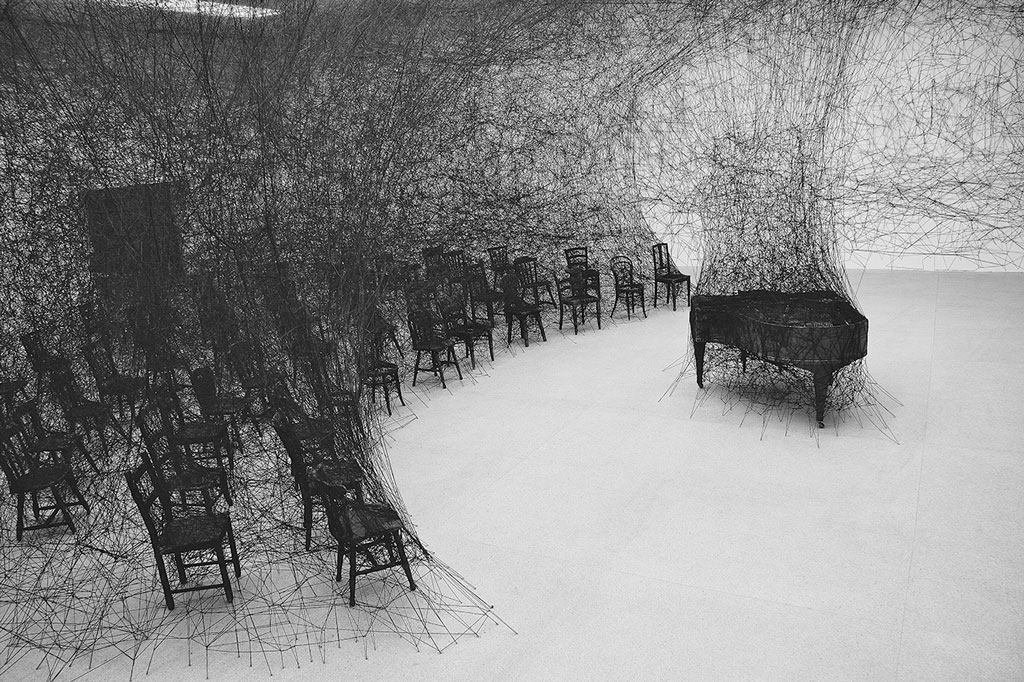ART-PREVIEW:Chiharu Shiota-The Soul Trembles
 Chiharu Shiota is known for performances and installations that express the intangible: memories, anxiety, dreams, silence and more. Often arising out of personal experience, her works have enthralled people all over the world and from all walks of life by questioning universal concepts such as identity, boundaries, and existence. Particularly well-known is her series of powerful installations consisting of threads primarily in red and black strung across entire spaces.
Chiharu Shiota is known for performances and installations that express the intangible: memories, anxiety, dreams, silence and more. Often arising out of personal experience, her works have enthralled people all over the world and from all walks of life by questioning universal concepts such as identity, boundaries, and existence. Particularly well-known is her series of powerful installations consisting of threads primarily in red and black strung across entire spaces.
By Efi Michalarou
Photo: Mori Art Museum Archive
The title of Chiharu Shiota’s solo exhibition “The Soul Trembles” references the artist’s earnest hope to deliver to others soul-trembling experiences derived from nameless emotions. While Shiota’s dynamic and immersive installations consisting of threads strung across entire gallery spaces are particularly well-known, this is a rare opportunity to experience in detail 25 years of Shiota’s oeuvre; primarily in six large installations, plus sculptural works, video footage of performances, photographs, drawings, performing arts-related material, etc. Taking as her theme “presence in absence” Shiota Chiharu has consistently given shape to the auras and energies of things that possess no physical presence, existing only in memories and dreams. Shiota sees her own soma and her works as inseparable entities, and the fact that her body has not featured in her works, apart from a limited number of videos, since her early performances, is also perhaps designed to draw our attention to “presence in absence”. However, when Shiota was informed the year before last that her cancer had returned and started mechanically embarking on the process of hospital treatment, she says she started to wonder about the location of the soul. Through it all, gripped by a sensation akin to her body fragmenting, she started to collect parts of broken dolls, and make bronze casts of her hands and feet once more. In her new installation for this exhibition, body fragments are threaded together, positing questions of the soul and the meaning of life. The motif of the boat features frequently in Shiota Chiharu’s works, conjuring up visions of uncertain lives and futures akin to tiny boats bobbing in vast oceans. In “Where Are We Going?” 100 boats suspended from an 11-meter-high ceiling greet visitors as they enter the museum, inviting them to embark on the journey of the exhibition. The first installation encountered upon entering the galleries, “Uncertain Journey” consists of the bare frames of boats arranged in a space covered in bright red threads. In her work for the Japanese Pavilion at the 2015 Venice Biennale, Shiota hung a mass of keys from the top of an old traditional Venetian boat, but in Uncertain Journey, the boats are more abstract, and the space filled with red thread seems to suggest the many encounters awaiting at the end of this uncertain journey. “In Silence” was born out of a memory of the next-door house burning down in the middle of the night when Shiota was a child. A burned piano and audience seating are covered, with the entire space, in black thread. While symbolizing silence, the soundless piano plays visual music. Like skin covering the body, dresses symbolize the boundary between one’s personal interior and exterior. Suspending such a dress in a space filled with black thread imparts a sensation of presence in absence. By hanging dresses on either side of a mirror dividing a space enclosed by a steel frame, “Reflection of Space and Time” blends in the mind of the viewer the illusory dress in the mirror, and the actual dress in the space opposite. Around 2004, fifteen years after the fall of the Berlin Wall, Shiota Chiharu who moved to Germany in 1996 and is currently based in Berlin started making works using windows. At the time, Berlin was undergoing extensive redevelopment that included demolition of many buildings, and Shiota went around gathering up discarded windows. Windows exist as a boundary between the inside and outside of private spaces, but also call to mind the wall that separated East and West Germany. The work “Inside – Outside” presented in this exhibition was first made in 2009, and there are several versions, this one using 250-300 window frames. The final work in the exhibition is the installation “Accumulation – Searching for the Destination” made up of around 400 oscillating suitcases. Shiota was inspired to create the installation by the discovery of old newspapers in a suitcase she found in Berlin. All things have their own, innate memories, and in this case, the suitcases seem to suggest the memories, movement and migration of strangers; or the refugee’s journey in search of a fixed abode; that is, the very journeys of people’s lives.
Info: Curator: Kataoka Mami, Mori Art Museum, Roppongi Hills Mori Tower, 6-10-1 Roppongi, Minato-ku, Tokyo, Duration: 20/6-27/10/19, Days & Hours: Mon & Wed-Sun 10:00-22:00, Tue 10:00-17:00, www.mori.art.museum






